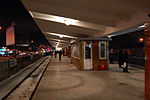V.N. Shimanovsky Ukrainian Institute of Steel Construction
V.N. Shimanovsky Ukrainian Institute of Steel Construction is a Ukrainian scientific research and design organization that specializes in the design and construction of bridges, towers, plants, stadiums and other structures in Ukraine, the former Soviet republics and other countries. The institute is run by the Ministry of Regional Development, Construction, and Communal Living of Ukraine of the Government of Ukraine. It is located in Kyiv. The institute has created television towers in Kyiv, St. Petersburg, Yerevan, Tbilisi, and Kharkiv, It has built plants in Algeria, Nigeria, India and Turkey. One of the institute's largest projects was the construction of the Paton Bridge over the Dnieper River in Kyiv, the first all-welded bridge in the world
Excerpt from the Wikipedia article V.N. Shimanovsky Ukrainian Institute of Steel Construction (License: CC BY-SA 3.0, Authors).V.N. Shimanovsky Ukrainian Institute of Steel Construction
Heorhia Narbuta Avenue, Kyiv Лівобережний масив
Geographical coordinates (GPS) Address Nearby Places Show on map
Geographical coordinates (GPS)
| Latitude | Longitude |
|---|---|
| N 50.4557 ° | E 30.6056 ° |
Address
Heorhia Narbuta Avenue 1
02100 Kyiv, Лівобережний масив
Ukraine
Open on Google Maps










